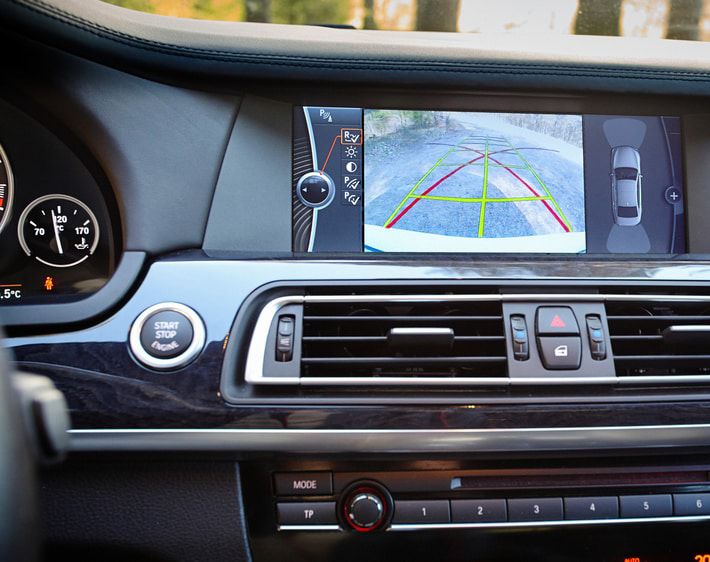Advanced Driver Assistance Systems, or ADAS, are systems on your vehicle that can enhance safety features, provide a better driving experience, and sometimes even drive the car for you! While some ADAS features have become standard, others are limited to specific makes, models, and trim levels. But as with most advancements in modern vehicles, these ADAS features can require special attention when getting your car serviced.
Advanced Driver Assistance Systems at a Glance
As automotive manufacturers strive for smarter and safer cars, the list of ADAS features grows on! To help you understand ADAS features and which ones require special attention, we'll label them as either common (found on most vehicles), progressive (becoming more popular and accessible), or high-tech (not standard, and usually found on higher-end models).
Common Advanced Driver Assistance Systems
Common ADAS features tend to be present on most car makes, models, and trim levels. These standard features might include:
- Anti-Lock Brake System: Keeps your brakes from locking up so your tires can maintain traction when stopping.
- Cruise Control: A computer monitors and controls your vehicle's speed, maintaining it at a steady pace set by you (the driver).
- Tire Pressure Monitoring Sensors: Sensors monitor the pressure in your tires and alert you when one of your tires has low pressure.
Even though these features might not seem so advanced nowadays, they are still considered ADAS features since they assist in safety and functionality.
Progressive Advanced Driver Assistance Systems
Progressive ADAS technology includes features that are currently not considered standard, but they are increasing in popularity and accessibility. You may find this tier of features on mid-to-high-end vehicle models and trim levels. Some of these ADAS features are:
- GPS and Navigation: GPS tracking monitors your vehicle's position and includes an on-board navigation display.
- Electronic Stability Control: Detects if your vehicle skids or loses traction and either applies brakes or reduces engine power until control is regained.
- Forward Collision Warning: A camera, radar, or laser monitors the front of your vehicle and alerts you to potential collisions. The system may apply the brakes for you if the vehicle has Autonomous Emergency Braking.
- Backup Camera: A rear camera is activated when the vehicle is in reverse and displays the view on an on-board screen. The system may apply the brakes for you when obstacles are present if the vehicle has Autonomous Emergency Braking.
- Blind Spot Monitors: Cameras or sensors detect vehicles and objects in the vehicle's blind spots and alert the driver.
Progressive ADAS features like these are becoming more accessible as an increasing number of manufacturers incorporate them into their vehicles. However, many automakers still offer these features in the form of extra technology packages or higher trim levels.
Some of these progressive features might require special attention when getting your vehicle serviced. If the feature relies on cameras, lasers, or sensors to do its job, there's a chance that the technician will need to perform a Safety Systems Alignment, which can add additional time and cost to your service appointment.
High-Tech Advanced Driver Assistance Systems
High-tech Advanced Driver Assistance Systems include features that are mostly found on higher-end models and trim levels. You may also find these features on luxury brands and tech-driven makes like Tesla. High-tech features may provide autonomous capabilities and advanced safety functions that give the vehicle more control and responsibility. High-tech ADAS features might include:
- Lane Departure Warning System: Cameras track the vehicle's location between the lanes in the road and alert the driver if the vehicle is exiting the lane.
- Automatic Parking: The vehicle uses cameras, sensors, or radars to detect objects around the vehicle and plot a path for the car to navigate on its own.
- Adaptive Cruise Control: When cruise control is activated, cameras, sensors, or lasers monitor the vehicle’s distance from neighboring cars. Computers slow down or speed up the vehicle to keep a safe distance.
- Collision Avoidance System: Cameras, lasers, and sensors stop the vehicle if an imminent impact with another vehicle, object, or person is detected.
Most high-tech ADAS features tend to rely heavily on the use of cameras, sensors, lasers, and even GPS to steer, control, or brake the vehicle. Additionally, most high-tech ADAS features require special attention or need a Safety Systems Alignment when getting your tires or brakes serviced. An expert technician must use specialized equipment to recalibrate every piece and part. If left out of alignment, your self-parking car could cause a lot of damage when squeezing into a tight parking spot!
Are ADAS Features Expensive?
While these advanced features can offer a safer and better driving experience, they can also come at a cost. Adding these high-tech safety features when purchasing a new vehicle can easily tack on thousands of dollars to the price tag. Some manufacturers may help you save some money by bundling certain available features into a "technology package." But even these upgrade bundles can put a dent in your wallet.
Additionally, repairing damaged high-tech safety systems can potentially set you back hundreds or even thousands of dollars, depending on what features were affected. Even a minor fender bender could cost you as much as $5,300, according to AAA.
While the upfront and repair costs of ADAS features might be a little high, the cost of not having these features could be much higher! A 2018 study from J.D. Power revealed that 49% of vehicle owners with blind-spot monitors say the feature helped them avoid a collision, while 35% of people with forward collision warning and collision avoidance systems report that the features prevented a crash. So, while manufacturers are putting a price on safety, it may be one that's worth paying.
Give Your ADAS Vehicle the Attention It Deserves
Your ADAS is always looking out for you. Are you looking out for it? If you have one or more ADAS features on your vehicle, give them the special attention they need to help keep you safe on the road. Schedule an appointment at a Firestone Complete Auto Care near you for your next routine service appointment, and our expert technicians will determine if your vehicle requires a Safety Systems Alignment*.
*Most Firestone Complete Auto Care locations offer Safety System Alignments, but capabilities vary per store. Call your local Firestone Complete Auto Care to check service availability.



